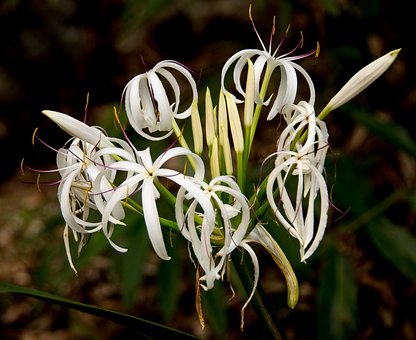Growing Crinum Lilies Successfully

The crinum lily is a tropical plant that can be found in many home gardens. This tropical beauty is a native of South Asia and produces white flowers that are very shower and eye-catching. I have worked with these lilies on many garden projects and love to see them growing together in groups provided they have the proper spacing which is 4-6 ft
Crinum lilies can also be installed as a centerpiece and make a great stand-alone or specimen plant. The Queen Emmas has big purplish leaves and a nice fragrance. Queen Emmas can also reach a height of 5-6 ft, The crinum lilies have a few common names such as the swamp lily, Bengal lily, and the spider lily. These garden beauties can be purchased from your nursery or garden center as a full-plant or as bulbs. To grow crinum lilies follow these steps for garden success.
Things you must know
- Planting Location
- Soil Type
- Watering Methods
- Fertilizing Methods
- Garden insect pests of the crinum lily
- Diseases of the crinum lily
- Ideas where to install crinum lilies
Planting Location
These Bulbs should be planted in early spring in full to partial sun.
Soil Type
The soil of the crinum lily should be soil that is organic-rich.
Watering Methods
Ensure that the soil is moist especially during long dry periods, allow the soil to dry out somewhat then water again.
Fertilize Methods
During the growing season fertilize with a balanced liquid feed fertilizer of 20-20-20. Before applying read and follow the manufacturer’s label because the label is the law.
Garden insect pest of the crinum lily
The good news is there is no know garden insect pest of the crinum lily at least I have never come across any.
Diseases of the crinum lily
The crinum lily does have its share of diseases which are.
- Powdery Mildew
- Botrytis Blight
- Anthracnose
Powdery Mildew
This fungal disease appears on the surface of the leaves of the crinum lily. This fungal disease is encouraged by long periods of warmth and moisture. The fungal spots are small and white to grayish in color, If not treated the number of fungal spots will increase. The leaves will also be covered with a white powder mass on the surface.
The infected plant will have stunted leaves that are yellow and curled. The leaves will then begin to decay. Wipe the infected leaves with a damp cloth and apply a fungicide. Leaves that are totally yellow and sickly should be removed with a pruner.
Botrytis Blight
This disease will infect the entire plant. Signs of this disease are drying tissues that appear brown, also wilting, and death of the leaves. These infected leaves should be removed with a pruner. Disinfect or sterilize the pruner after procedures. The use of fungicides that are formulated for this disease will help your crinum lily bounce back to good health. It is best to treat this disease in the early stages for the best results.
Anthracnose
Leaves that are not cleared from your crinum lily but is allowed to remain on the surface of the soil during the colder months encourages this fungus. When spring comes the fungus is carried by rain and wind to your lilies. The leaves that are infected develop spots that are small and dark.
These spots will decay in time with leaves that curl at the edges. To treat or control this disease ensure that the beds or surrounding area are well cleaned also applying a copper-based fungicide will bring this disease under control.
Caution
Before using chemicals or treatments read and follow the manufacturer’s label because the label is the law.
Ideas where to install crinum lilies
- Crinum lilies can be installed along walls
- Can be installed along fences
- Can be used as a specimen plant
- Can be installed in garden plant beds as a backdrop
- Plant them along a garden path
- Place in containers and install at door entrances
- Plant alongside patios and porches
Container grown crinum lilies
Crinum lilies can also be successfully grown in containers. The container should be large enough to accommodate your crinum lily at maturity and should have drain holes for water to escape. Crinum lilies don’t like wet feet which can encourage root rot. The soil should be well-drained soil that will also hold the right amount of water.
The container should be placed in an area that gets full to partial sun, fertilize with a liquid feed as stated above and follow the guide on the label for best results for your plant’s health.
Pruning Procedures
At times the leaves may need to be removed. Keep a sharp pruner close by and remove the crinum lily leaves from the trunk making a clean cut.
The final word
Crinum lilies are great to have as a part of your garden design. This tropical beauty has proven that they can give your gardens and landscapes that much need look. These lilies will do well planted in a garden area that is near to a pond and in full bloom, this bulb will give that WOW so go ahead, make the crinum lily a part of your garden and landscape design.
About the author
Norman loves being in the garden, both at home and for his job....
he is 'Natures Little helper' being outdoors, growing his vegetables and flowers from an early age.
Now having spent over 22 years in the profession he want to give some of his knowledge to others...
his vast array of hints and tips you will find scattered over this site will help you no end growing plants in your garden.
